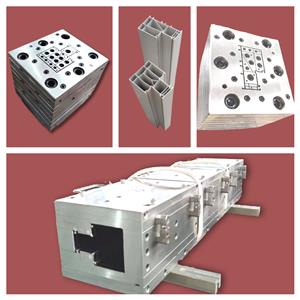PVCプラスチック、押出金型の構造がベールを脱ぎます
一般的に使用される金型には、プレート段付き金型と断面勾配金型の 2 つの形式があります。プレート段付型は、複数の口金型を直列に接続して流路が段階的に変化します。各プレートは対応する輪郭形状に機械加工され、入口の丸い形状から目的の出口形状に徐々に変化します。各ブロックの入口には、ある形状から別の形状への移行を完了するためのベベルがあります。この種の金型加工コストは低く、流路は理想的な流線形ではなく、一般にメイン プロファイルとして使用する必要はありません。断面勾配金型ランナーは流線型で、ランナー内に材料の滞留ゾーンが存在せず、溶融物は入口の円から出口形状の各セクションに徐々に正確に分配され、速度は着実に増加します。必要な出口速度、およびセクション上の各ポイントの速度は同じです。複雑なモールド コアを備えた PVC プラスチック プロファイルの場合、モールド コアはブラケット プレートと一体化されているか、位置決めピンとネジによってブラケット プレートに固定されているもの、またはしっかりとしたインレイによってブラケット プレートに埋め込まれているものがあります。再組み立てやデバッグには時間がかかるため、使用中に簡単に分解することはできません。溶融物のシャントも、シャント コーン上と圧縮セクション内の 2 つの方法で実行されます。断面勾配モールドをメインプロファイルモールドとして使用できます。PVC プラスチック異形押出金型は、マウスダイ (ダイヘッドとも呼ばれる)、成形金型、冷却水タンクなどを含む押出生産ラインの核心部分です。マウスダイは、押出機ヘッドのフランジと次の方法で組み立てられます。フランジの、加熱リング、加熱プレート、電源、熱電対が接続されています。成形テーブルに成形型と冷却水タンクをネジで固定し、水道管とガス管を接続します。押出ダイの基本構造は、複数のテンプレートを積層して組み立てた構造として設計されるのが一般的です。したがって、型全体の流路は、各テンプレートの表裏の流路を接続することによって形成されます。プレートワークを位置決めし、ピンとボルトで固定して、モノリシック押出ダイを形成します。基本的な状況は次のとおりです。押出ダイの定常流セクションは多孔板とネックの前半部で構成されることが多く、ネックの前半部と後半部もネックとネックの 2 つのテンプレートとして設計されています。ネックトランジションプレート。多孔質板を使用せず、ネック流路の前半部分を円筒流路として流れを安定化することも可能である。押出ダイの分割部はネック後半から始まり、スプリットコーン、スプリットブラケットプレート、シュリンクプレートで構成されます。シュリンクプレートは単一の型枠に分割するのではなく、予備成形プレート、つまり型枠と一緒に分割することができます。押出ダイの成形セクションには、キャビティ プレート (予備成形プレートとも呼ばれます)、マウス テンプレート (成形プレートとも呼ばれます)、およびコア (モールド コアとも呼ばれます) のテンプレートが含まれます。より単純なプロファイル ダイの場合は、予備成形プレートを口テンプレートと組み合わせて 1 つの型枠を作成します。1. 製品断面設計のキーポイント PVC プラスチックプロファイル製品設計のキーポイントは、マシンヘッド内の材料の流れのバランスが取れ、冷却が均一になるように、各セクションの厚さと形状が対称に分布する必要があることです。 、圧力のバランスがとれる傾向があります。一般に、同じセクションの最大肉厚と最小肉厚は異なります。 < 50% is appropriate. If it is a part of a closed rib, the thickness of the rib should be 20% thinner than the wall thickness. In order to avoid the stress concentration at the corner of PVC plastic profile products, the shape change of the product should be smooth and smooth transition, generally the outer corner R is not less than 0.5mm, the inner corner R is not less than 0.25mm. The hollow part of the product should not be too small. The cross-sectional shape is preferably symmetrical. 2. Structure type and design principle of mold The mold is the forming part of the extruder, which is mainly composed of neck seat, shunt cone, support plate (also known as bracket), core mold, mouth template and adjusting screw. PVC plastic profile extrusion die county is mainly composed of three sections: feeding section one by machine base and distribution cone composed of machine head flow channel feeding section, is conical: melt distribution and forming section one by support plate and mouth die compression part constitute melt distribution and forming section, the shape is gradually close to the PVC plastic profile section, parallel section mouth die and core die constitute the machine head parallel section, (1) There are two types of mold structure for extruded plastic profiles: plate head and streamlined head. According to the different methods of processing and manufacturing the machine head, the streamlined head fork is divided into integral streamlined and segmented (also known as stepped) streamlined. (2) Mold design principle The mold is the key part of PVC plastic profile extrusion, and its function is to extrude a blank similar to the profile under the action of 10~25MPa extrusion force. PVC plastic profile mold runner design principle is that the runner section should be streamlined: there is enough compression ratio and shaped length to form a certain extrusion pressure: the flow resistance balance and flow symmetry of the cross-sectional gap of each runner part of the mold. The flow channel structure of the PVC plastic profile head is generally divided into three parts: feeding, compression (also known as transition part) and forming. Generally speaking, the length of the feed part of the long runner is 1 of the length of the shaping part. About 5~2 times, the length of the compression part is about 2~3 times the length of the shaping part. The maximum cross-sectional area of the compression section is in the outlet area of the bracket. The shape of the support ribs of the bracketer. The broad one is jujube nucleus-shaped. The thin ones are long prismatic. The shape of the divergence in the front of the scaffold is that it converges at the same angle on all sides, forming a torpedo body shape. The flow rate of molten material is different in the flow channel of feeding, compression and forming, the feeding part is the smallest, the forming part is the largest, and the transition part must be in between the two and gradually increase in the direction of extrusion. The melt flow rate is inversely proportional to the cross-sectional area of the runner. The roughness of the runner in the head should be Ra0. 4~0.8ym, the roughness of the mouth mold runner of the stereotyped part is higher than the roughness of the inner runner, which should be Ra0.2~0. 4μm, When the extruded billet is just exported to the die, the size of the gap is increased than the mouth die, which is called the mold release expansion, that is, the Balas effect. This effect must be considered when the pulling speed of PVC plastic profile extrusion is slow and it is cooled near the outlet of the die mold. The release mold expansion of the outlet die is usually calculated by volume, and its expansion rate is generally 1.5~2.5 times, and this value changes with different aspects of melt temperature, pressure and velocity. The wall thickness size required for PVC plastic profiles depends on the wall thickness of the appropriate extruded billet on the one hand, and the pulling speed and extrusion amount on the other hand. The thickness of the extrusion blank wall mainly depends on the size of the mouth die gap, and then depends on the plasticizing performance of the material in the extruder, extrusion pressure, extrusion temperature, material performance and expansion value. First, the standard traction shrinkage rate for general wall thickness is ≤2.5%. The gap between the mouth die and the thickness of the product are taken (0.8~0.9) 1 1




